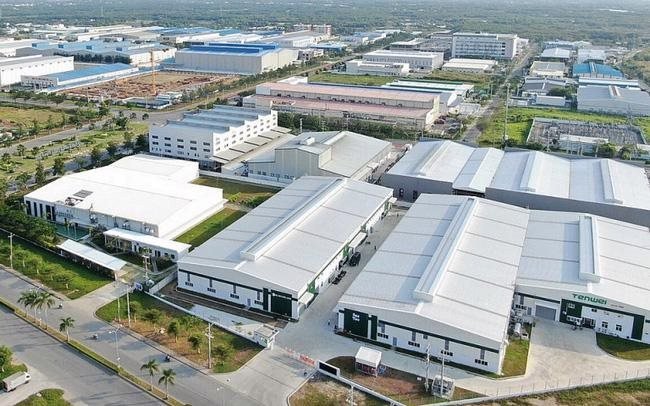
Throughout the gray picture, the industrial real estate sector has been considered the brightest segment in the market. Sharing recently, Ms. Trang Bui, CEO of Cushman & Wakefield, said that Vietnam is facing an opportunity to enhance the value of the supply chain of manufacturers, and this is a golden opportunity to increase the GDP of the region. Especially recently, in the visit of President Biden, an agreement on comprehensive cooperation and high-tech and semiconductor production market development between the two countries was brought.
The opportunity for industrial real estate comes not only from the wave of supply chain shifts but also from a series of government policies to promote investment in infrastructure development alongside investment incentives. According to PwC, Vietnam is the leading country in Asia in terms of infrastructure investment and is currently spending about 5.7% of GDP on this sector.
According to Ms. Trang, in the past 5 years, industrial parks have grown by about 15%, and other segments such as factories and warehouses have more than doubled since 2018.
This segment constantly welcomes “eagles” to build nests. Vietnam’s industrial parks have welcomed investment waves from global electronics companies since the early years, such as Panasonic (1971), LG Display (1995), Canon (2001), Foxconn (2007), Samsung (2008), Fuji Xerox (2013), and recently corporations such as Pegatron, Goertek, Jinko Solar.
Or in early November 2022, Lego Group of Denmark started construction of a $1 billion factory in Tan Uyen, Binh Duong – one of the largest FDI projects in the “industrial capital” Binh Duong and also one of the largest projects of Denmark investing in Vietnam.
According to statistics, by 2023, Vietnam has established 397 industrial parks with a total land area of 122,900ha. Of which, 292 industrial parks are in operation with a total land area of over 87,100ha, and another 106 industrial parks are being built with a total land area of 35,700ha. Notably, the occupancy rate of industrial parks nationwide is high, over 80%, of which key provinces in the South reach 91% and key provinces in the North reach 83%.
Regarding rental prices, a Q3 2023 report by CBRE Vietnam recorded the average industrial land lease price in level 1 markets in the South (including Ho Chi Minh City, Dong Nai, Binh Duong, Long An) reached $189/m2/remaining lease term, continuing to increase slightly by 1% compared to the previous quarter and 13% higher than the same period last year. Meanwhile, the average rental price for level 1 markets in the North (including Hanoi, Hai Phong, Bac Ninh, Hung Yen, Hai Duong) reached $131/m2/remaining lease term, increasing 2% per quarter and 12% per year.
There are many factors supporting the development of Vietnam’s industrial real estate market. Specifically, the country has a total road length of 595,201 km, of which the national road is 25,560km. The highway network has been put into operation with 1,239km; currently deploying the construction of about 14 routes, section of routes, equivalent to 840km. Major cities such as Hanoi prioritize the Beltway 4 project, while Ho Chi Minh City prioritizes Beltway 3 to enhance connections to neighboring localities, increase cargo transportation connections, and reduce logistics costs to seaports.
As for railways, the national railway network has a total length of 3,143km, with 277 stations and two routes connecting to China at Dong Dang and Lao Cai.
Regarding waterways, Vietnam’s seaport system in recent years has been invested with the scale and current technology reaching international standards, especially the container port system (the two largest ports in Vietnam – Hai Phong and Ho Chi Minh City are both among the top 50 largest container ports in the world).
Although the opportunity for Vietnam to attract investment inflows is huge, experts believe that the challenges are not small. In which, land prices are rising, infrastructure is not synchronized, labor productivity, and global instability are constraining the growth of the industrial park market.
According to the forecast for the industrial real estate market in 2024 by Mr. Alex Crane, CEO of Knight Frank Vietnam, this is still a segment of stable development, with some bright spots, but there are two emerging pressures. In which, the rate of asset capitalization value is facing pressure from inflation due to high financial costs, short land use terms, and competition with other markets that have significantly lower rental prices in the Asian region.
According to him, the capitalization rate in Vietnam is currently increasing from 9% to 12% due to the additional supply of high-quality ready-built factories and warehouses across the country. Ready-built factories and warehouses have attracted a strong inflow of foreign capital investment since 2018. The number of investors has also increased five times. The challenges arising from this explosion have created a tenant-friendly market, with an average rental price of about $4.5/m2/month in the South and $4.7/m2/month in the North.
The next pressure is the price competition with neighboring countries. For example, the industrial land rental price in suburban Bangkok (Thailand) is currently at $82-164/m2/remaining lease term, much lower than suburban Hanoi ($80-250/m2/remaining lease term) and suburban Ho Chi Minh City ($95-280/m2/remaining lease term).
“Industrial and manufacturing real estate is still a key market in Vietnam, however, it will face many challenges in attracting investment and filling ready-built land areas in 2024,” Mr. Crane forecasted.









































